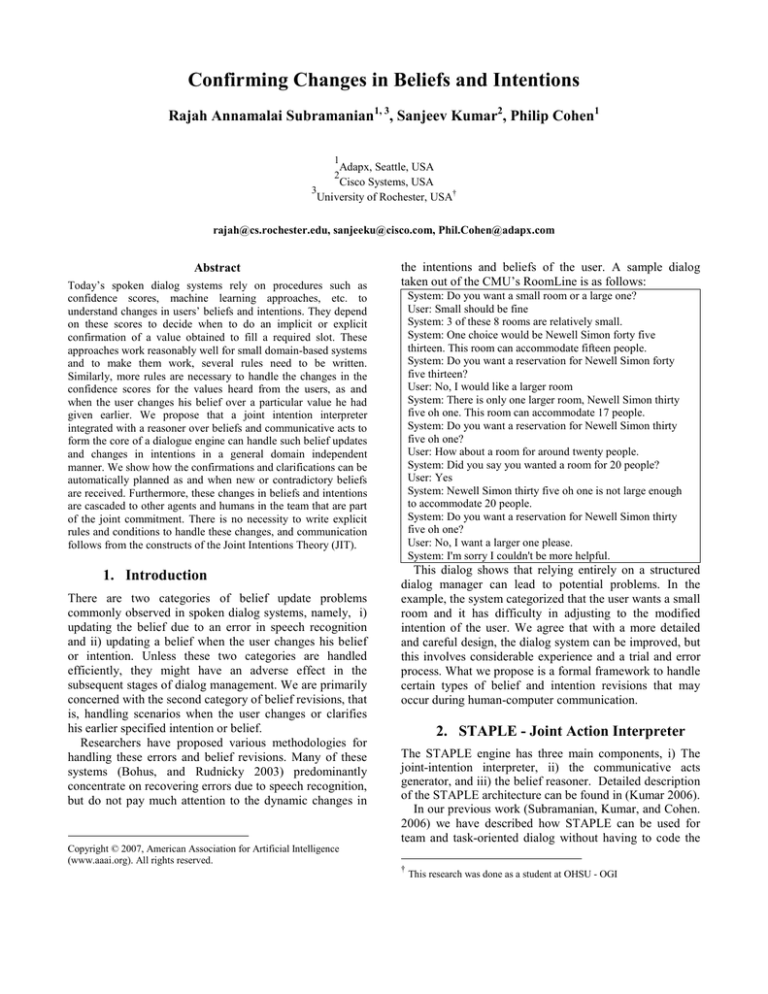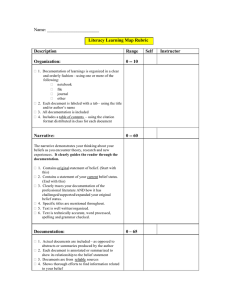
Confirming Changes in Beliefs and Intentions
Rajah Annamalai Subramanian1, 3, Sanjeev Kumar2, Philip Cohen1
1
Adapx, Seattle, USA
2
3
Cisco Systems, USA
University of Rochester, USA†
rajah@cs.rochester.edu, sanjeeku@cisco.com, Phil.Cohen@adapx.com
Abstract
Today’s spoken dialog systems rely on procedures such as
confidence scores, machine learning approaches, etc. to
understand changes in users’ beliefs and intentions. They depend
on these scores to decide when to do an implicit or explicit
confirmation of a value obtained to fill a required slot. These
approaches work reasonably well for small domain-based systems
and to make them work, several rules need to be written.
Similarly, more rules are necessary to handle the changes in the
confidence scores for the values heard from the users, as and
when the user changes his belief over a particular value he had
given earlier. We propose that a joint intention interpreter
integrated with a reasoner over beliefs and communicative acts to
form the core of a dialogue engine can handle such belief updates
and changes in intentions in a general domain independent
manner. We show how the confirmations and clarifications can be
automatically planned as and when new or contradictory beliefs
are received. Furthermore, these changes in beliefs and intentions
are cascaded to other agents and humans in the team that are part
of the joint commitment. There is no necessity to write explicit
rules and conditions to handle these changes, and communication
follows from the constructs of the Joint Intentions Theory (JIT).
1. Introduction
There are two categories of belief update problems
commonly observed in spoken dialog systems, namely, i)
updating the belief due to an error in speech recognition
and ii) updating a belief when the user changes his belief
or intention. Unless these two categories are handled
efficiently, they might have an adverse effect in the
subsequent stages of dialog management. We are primarily
concerned with the second category of belief revisions, that
is, handling scenarios when the user changes or clarifies
his earlier specified intention or belief.
Researchers have proposed various methodologies for
handling these errors and belief revisions. Many of these
systems (Bohus, and Rudnicky 2003) predominantly
concentrate on recovering errors due to speech recognition,
but do not pay much attention to the dynamic changes in
the intentions and beliefs of the user. A sample dialog
taken out of the CMU’s RoomLine is as follows:
System: Do you want a small room or a large one?
User: Small should be fine
System: 3 of these 8 rooms are relatively small.
System: One choice would be Newell Simon forty five
thirteen. This room can accommodate fifteen people.
System: Do you want a reservation for Newell Simon forty
five thirteen?
User: No, I would like a larger room
System: There is only one larger room, Newell Simon thirty
five oh one. This room can accommodate 17 people.
System: Do you want a reservation for Newell Simon thirty
five oh one?
User: How about a room for around twenty people.
System: Did you say you wanted a room for 20 people?
User: Yes
System: Newell Simon thirty five oh one is not large enough
to accommodate 20 people.
System: Do you want a reservation for Newell Simon thirty
five oh one?
User: No, I want a larger one please.
System: I'm sorry I couldn't be more helpful.
This dialog shows that relying entirely on a structured
dialog manager can lead to potential problems. In the
example, the system categorized that the user wants a small
room and it has difficulty in adjusting to the modified
intention of the user. We agree that with a more detailed
and careful design, the dialog system can be improved, but
this involves considerable experience and a trial and error
process. What we propose is a formal framework to handle
certain types of belief and intention revisions that may
occur during human-computer communication.
2. STAPLE - Joint Action Interpreter
The STAPLE engine has three main components, i) The
joint-intention interpreter, ii) the communicative acts
generator, and iii) the belief reasoner. Detailed description
of the STAPLE architecture can be found in (Kumar 2006).
In our previous work (Subramanian, Kumar, and Cohen.
2006) we have described how STAPLE can be used for
team and task-oriented dialog without having to code the
Copyright © 2007, American Association for Artificial Intelligence
(www.aaai.org). All rights reserved.
†
This research was done as a student at OHSU - OGI
communicative acts explicitly. In this position paper, we
propose to extend our work to handle certain changes in
beliefs and intentions of the communicating user.
We describe two important definitions and show how
they play a key role in generating communication for belief
changes. The KNOW-REF (Allen and Perrault 1980)
action is used to find out the value for the description of a
required variable. For example, in the room reservation
domain, the system has to know the values for the date,
time, size, etc. before it can search for rooms. The KNOWREF action has a precondition that if the agent believes
that there is another agent or human in the system that
knows the value for the required variable, then the agent
plans the communicative act ASK to the appropriate agent
or human. This principle leads to the automatic generation
of questions to the concerned agents or humans. This
action helps in establishing new beliefs between the user
and the agent regarding the required variables. The second
important definition is KNOW-IF. If the agent is not sure
about the truth value of a particular proposition, and if it
believes that there is another agent or human that can
ascertain the truth value, then an appropriate
communicative act (ASK-IF) is planned accordingly.
The STAPLE dialog engine can be designed to reference
an ontology (for example, a room reservation) for the
purpose of belief and intention elaboration and reasoning.
One categorization for the size of the room could be large
(>= 20 people) and small (< 20 people). This category is
part of the description of the room (time, date, size…). The
goal of the agent is to communicate efficiently with the
user and other agents to not only receive the necessary
information, but also to handle any change in intentions or
descriptions in a robust manner.
The agent, after forming a joint commitment with the
user to help the user reserve a room, tries to execute its
plan with the help of the action KNOW-REF to establish
initial mutual beliefs with the user regarding the time, date,
size etc. of the room. For example, from the sample dialog
in the introduction, the agent forms an initial belief that the
size of the room is small, and establishes mutual belief
between the agent and the user regarding the size of the
room. As the dialog continues, the agent receives an
INFORM from the user that he wants a large room (for 20
people). This contradicts the existing mutual belief of the
agent regarding the size of the room (that can be reasoned
from the ontology definitions) and the agent adopts an
intention to establish mutual belief one way or the other.
To do so, it has to confirm if the user believes p (small
room) or ~p. This uncertainty, along with the knowledge
that the user knows the value of the size of the room
triggers the precondition of the action KNOW-IF to
ascertain if the user intends to reserve a small room or not.
The result of executing KNOW-IF is that an explicit
confirmation REQUEST is planned to the user regarding
the value of the uncertain predicate. If we include task
optimization, we should be able to simultaneously handle
the intention for establishing mutual belief about p or ~p
with the intention of room reservation to generate implicit
confirmations. STAPLE uses concurrent Intention –
Commitment (IC) stacks (Kumar 2006) to keep track of the
sub-dialogs that occur in communication. With the help of
the room ontology, STAPLE should be able to reason
about the description in the ontology at which the user
intention has changed (in this case it is the size of the
room). The confirmations are planned only for this
particular intention change whereas the other beliefs and
intentions (such as date, time etc.) are not affected, i.e., the
IC stacks of only the relevant intentions and goals are
affected. If a higher level intention is modified then
subsequent sub-intentions that are not affected by the new
belief still use values from the belief base that were
communicated earlier.
Another effect that falls out of the JIT (Cohen and
Levesque 1990) is that, if there is a team of agents working
together to solve a common problem, and if one of them
comes to privately believe that there is a change in status
of the action that is being executed, it takes up an
individual goal to establish mutual belief with the other
agents in the team. For example, in the room reservation
domain, if the system agent has relegated the task of
getting the roster of rooms to another agent, say the
database agent, then there is a joint commitment between
the two agents to get the roster of rooms. If the system
agent comes to know from the user that there is a change in
the user’s intentions (either regarding an action or a change
in belief of some values), the system agent takes up an
individual goal to establish mutual belief with the other
agent(s) regarding the change in the action or value.
Thus, by the JIT framework we should be able to handle
confirmations due to changes in beliefs and intentions in a
domain independent manner.
3. References
Allen, J. F. and Perrault, C. R. 1980. Analyzing Intention
in Dialogues. Artificial Intelligence., 15(3): 143-178.
Bohus, D., and Rudnicky, A., 2003. RavenClaw: Dialog
Management Using Hierarchical Task Decomposition and
an Expectation Agenda, Eurospech-2003, Switzerland.
Cohen, P. R. and Perrault, C. R. 1979. Elements of a PlanBased Theory of Speech Acts. Cognitive Science.
Cohen, P. R. and Levesque, H. J. 1990. Intention Is Choice
with Commitment. Artificial Intelligence, 42: 213-261.
Kumar, S., 2006. A Formal Semantics of Teamwork and
Multi- agent Conversations as the Basis of a Language for
Programming teams of Autonomous Agents. Ph.D. diss.,
Oregon Health and Sciences University.
Subramanian, R. A.; Kumar, S.; and Cohen, P. R. 2006.
Integrating joint intention theory, belief reasoning, and
communicative action for generating team-oriented
dialogue. In AAAI-06.




